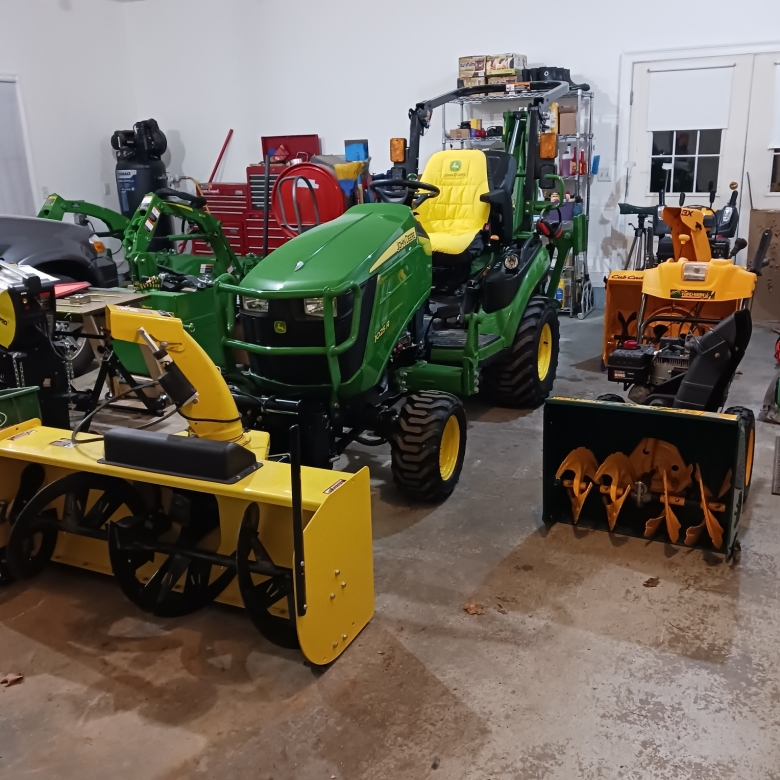
11/19/2023 – Seems like it takes longer, each year, to change over from landscaping to snow removal. Since both coop space in the garage, the lawn shed is the buffer for rotation. Now I just resign myself to pulling everything out that needs to be and replacing it with not for the season.
The Skippy change over is easy; pull the loader and attaching the snow blower. The backhoe stays on this year for ballast. A bright yellow/white rotating strobe sits on the ROP. Too easy to get swatted in the dark by neighbors heading to, or coming home, from work.
The small equipment is more time consuming with oil changes, air filters, spark plugs, general nuts and bolts check. But all set now, so let it snow, let it snow, lets it… Where is the humor in all of that? There is none, but I can offer some irony.
I never liked Buffy Sainte-Marie, a dislike developed in the 60s, based on her exaggerated vibrato. So the other day, I heard her rendition of “Helpless” and I found it to be incredible… haunting, spiritual… Pretty OK. On the same day, I learned Buffy Sainte-Marie was a member of the Elizabeth Warren Native American tribe, born in Massachusetts to parents of Western European descent. I am not sure the latter matters, as the song is a solid tribute to what she always claimed to be.
Settling in with the Dark Series Model 1895
More time shooting the Dark Series Marlin Model 1895 proved worthwhile. A change to brush guarded red dot sight, as opposed to a scope, was a good Maine woods accommodation. The red dot is faster on target and tracking moving targets, and shooting with both eyes provides broader awareness of surroundings.
Shooting a lot of rounds within a compressed time frame, and suppressed, proved the aluminum handguard to be an asset. It reduced weight forward of the trigger, and the well vented aluminum dissipates barrel heat fast enough to protect hands. Actually, with temperatures dropping below 30°F, the handguard became a very nice hand warmer.
The Torx head screws, replacing all of the early cross slot screws, are a nice touch. They provide a better driver grip, and eliminates screw driver scratches and chewed up cross slot screw heads. It is also a good modern machine look.
45-70 Gov’t Essential three.. four.. five.. six.. seven.. six bullets
Let me be the first to use the term “eclectic selection” in concert with guns and ammunition. Below, a selection of component bullets that fill most 45-70 Govt applications. All but one worked well with the Model 1895, and that one was an attempt to adapt a Ruger No. 1 favorite handload to the Dark Series lever action. A more detailed explanation is provided further on.
Pictured above, L-R: Barnes TSX FN 300 grain, Nosler Partition 300 grain, Remington Core-Lokt 300 grain JHP, Hawk Precision 350 grain 0.035″ copper jacket, Hawk Precision 400 grain 0.025″ copper jacket, Swift A Frame 400 grain, hard cast 500 grain.
The Barnes bullet was included for folks hunting in states where leadless bullets are mandated. They do perform well at standard and +P velocity; expand and stay together. However, they take a little work to reach velocity levels of conventional lead core/jacked bullets with lesser bearing surface.
The Nosler Partition indicated is a wonderful bullet. Excellent controlled expansion and penetration and they do hold up. Unfortunately, they are currently obsolete. When my supply is exhausted, I will probably go to… Nope, I have no idea. Many of the stout 0.458″ bullets used in stout 45-70 loads were intended for use with the 458 Winchester. That cartridge, and similar big bore centerfire rifle rounds once touted for use on the Big Five, are not enjoying wife popularity these days.
Hawk Precision bullets are pure copper jacketed, with soft lead cores and optional jacket thicknesses. In this case, 0.035″ for the 300 grain, and 0.025″ for the 400 grain. They expand very well across a broad velocity range and they don’t fragment.
This 400 grain Swift is of very tough construction, harder lead core, and good performance at +P levels. It is intended for the 458 Winchester Magnum, but it has done well with pushed 45-70 loads and the Ruger No.1 single shot. Swift also makes a.. stubbier 350 grain bullet specifically for lever action rifles. Let’s call that one the correct bullet.
An attempt to adapt the 400 grain A-Frame for use in the Model 1895 fell flat. The reason given for the poor showing is purely speculative on my part, so maybe someone looking over my shoulder can venture something more.
The 500 grain hard cast offers virtually no expansion, but very deep penetration, and is good for close in shots at heavy bodied game, or taking down oak trees. It is also a good subsonic selection, if there is such a thing for the 45-70.
An accommodation for a bullet… my sad story
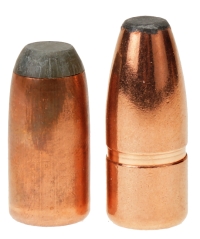
For 45-70 Govt lever gun use, the Hawk Precision 400 grain probably makes more sense than the Swift A Frame at 400 grains. The Swift’s long ogive, while making for an good ballistic coefficient, results in a longer than standard cartridge overall length; 2.770″ vs 2.550″.
The Swift bullet measures 1.145″ in length and the cannelure is 0.400″ up from the bullet’s heel. The Hawk Precision is 0.980″ long and does not have a cannelure.
Consequently, Swift bullet handloads will not feed through the Model 1895’s loading gate and, if you manage to get one in the rifle’s magazine, it will stubbornly not feed or come out without partially disassembling the rifle. The cartridge, assembled with the case mouth indexed to the bullet’s cannelure will also not work,. The bullet’s ogive will contact the rifling leade and the lever will not compress the trigger block mechanism. Nice to have this safety built in.
An attempt was made to resuscitate
Unmodified cases, combined with the Swift bullet, assemble to a cartridge overall length of 2.770″, or 0.220″ longer than spec. So 45-70 brass was trimmed from a measured 2.009″ to 1.880″.
In reducing case length, case capacity was reduced from 79 grains to 69 grains, However, with the Swift bullet seated to an overall cartridge length of 2.550″, there was still more than enough net capacity to accommodate powder charges.
Because the net case capacity is diminished, powder charges developed from the full length cartridge for use in the Ruger No. 1 needed to be reduced to avoid excessive pressure.
The results were left on the load data table, however, they were not good at all. In fact, the 400 grain Swift performance, with modified cases, were outperformed by the 500 grain cast bullet load.
My theory, and I am sticking to it, is that while shortening a case to accommodate a long bullet is common… as in most Hornady FTX loads, there is a limit. The 45-70 Govt is a tapered case. The mouth is 0.480″ OD, the case body at the rim is 0.506″.
Without giving myself a geometry headache, I would estimate 0.200″ down the chamber, the inside diameter is close to 0.490″. A good deal of pressure would be lost to forcing the case mouth to form to the chamber and seal. Although, even suppressed, cases were not blackened. Nearly 400 fps under a 400 grain bullet goal, it was time to move on. Safety ahead of curiosity.
The rest of the bullets even worked better with powder… and stuff
A reminder, the Dark Series Model 1895 is a compact lever gun. Subsequently, it has a short 16.1″ barrel. However, most handload data and follow on velocity is predicated on the use of a SAAMI standard 24″ test barrel. Unless you are shooting a musket, please set aside the 4,000 fps 405 grain expectations.
Warning: The handload data that follows exceeds SAAMI pressure standards for the 45-70 and recommendation for use by Ruger. Bullet selections are specific, and loads are not valid with substitutions of different bullets of the same weight. Variations in bullet length will alter net case capacity, pressure and velocity. Primer selection is specific and primer types are not interchangeable. These are maximum loads in my firearms and may be excessive in others. All loads should be reduced by 5% as a starting point for development where cartridges have greater than 40 grains in capacity and 10% for cartridges with less than 40 grain capacity following safe handloading practices as represented in established mainstream reloading manuals. Presentation of these loads does not constitute a solicitation for their use, nor a recommendation.
| 45-70 Gov’t +P Marlin Model 1895 +P Lever Gun or stronger |
|
| Firearm | Marlin Model 1895 Dark Series |
| Barrel Length | 16.1″ |
| Min – Max Case Length | 2.105″ +0.0″/-0.020″ |
| Min – Max Cartridge Overall Length | 2.490″ – 2.550″ |
| Primer | CCI 250 – Large Rifle Magnum |
| Bullet Diameter | 0.458″ +0.0″/-0.003″ |
| Reloading Dies | RCBS + Lee Precision Crimp |
| Bullet Type | Bullet Weight Grains |
Net H2O Grains Capacity |
COL” | Powder Type | Powder Charge Grains |
Muzzle Velocity fps |
Muzzle Energy ft/lbs |
3 Shot 100 YD Group“ |
| Barnes TSXFN | 300 | 50.5 | 2.525 | Reloder 7 | 46.0 | 1881 | 2358 | 0.9 |
| Barnes TSXFN | 300 | 50.5 | 2.525 | IMR 4198 | 44.5 | 1805 | 2171 | 1.2 |
| Nosler Partition | 300 | 62.5 | 2.535 | Reloder 10x | 56.0 | 1924 | 2467 | 1.1 |
| Nosler Partition | 300 | 62.5 | 2.535 | Win 748 | 65.0 | 1903 | 2413 | 1.0 |
| Remington JHP | 300 | 63.3 | 2.550 | Reloder 10x | 57.0 | 1929 | 2479 | 0.7 |
| Remington JHP | 300 | 63.3 | 2.550 | Win 748 | 65.0 | 1945 | 2521 | 0.8 |
| Hawk Precision 0.035 | 350 | 60.7 | 2.550 | Reloder 10x | 52.0 | 1862 | 2695 | 0.9 |
| Hawk Precision 0.035 | 350 | 60.7 | 2.550 | H335 | 58.5 | 1853 | 2669 | 0.6 |
| Hawk Precision 0.025″ | 400 | 56.9 | 2.550 | Alliant AR Comp |
53.0 | 1772 | 2790 | 0.7 |
| Hawk Precision 0.025″ | 400 | 56.9 | 2.550 | H335 | 55.0 | 1806 | 2898 | 1.0 |
| Swift A Frame Short Case(1) |
400 |
56.5 |
2.550 |
Reloder 10x | 48.0 | 1666 | 2466 | – |
| Swift A Frame Short Case(1) |
400 |
56.5 |
2.550 |
H335 | 54.0 | 1673 | 2487 | – |
| Hard Cast FN | 500 | 44.9 | 2.550 | Reloder 10x | 38.5 | 1451 | 2338 | 0.6 |
| Hard Cast FN | 500 | 44.9 | 2.550 | Trail Boss | 14.0 | 915 | 930 | 1.2 |
| Hard Cast FN | 500 | 44.9 | 2.550 | Trail Boss | 16.0 | 942 | 985 | 1.3 |
| (1) Information only. Cases trimmed to 1.880″ and 2.550″ COL. | ||||||||
Anything that stood out? Nope
Brass was once fired Winchester Western, sonic cleaned, then dumped in the vibratory cleaner with walnut medium. All cases were full length sized, trimmed to length, inside/outside mouth chamfered, and expanded with a minimal flare.
Bullets were seated, then crimped with a Lee Precision crimp die with the exception of the 45-70 Shorts. Too short for the collet crimp dies, they received a roll crimp.
Cases were easy to extract, no real signs of case stretch above the rim, and they all loaded from the magazine, feed and cycled without a hitch.
Subsonics where very quiet, but far from silent. A function of short barrel muzzle pressure.
Why the magnum primers? To each his own…
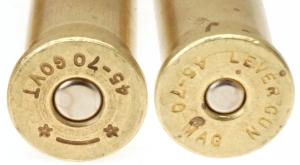 There are many theories serving as a foundation for primer selection, and almost all of them won’t prove out as soon as powder types, charge density and bullet type and weight change. Specifically with the 45-70 Govt, my collection of handload recipes and working pressure levels, large rifle magnum primers work for me.
There are many theories serving as a foundation for primer selection, and almost all of them won’t prove out as soon as powder types, charge density and bullet type and weight change. Specifically with the 45-70 Govt, my collection of handload recipes and working pressure levels, large rifle magnum primers work for me.
There are some near full case loads on the preceding table, but none that are tightly compressed. If there were, a large rifle primer would have been used. Reason? Personal experience is magnum primers behind a compressed charge driving bullets out from the case prior to full ignition. The result is diminished and erratic pressure/velocity.
Small rifle magnum primers where brass allows has not worked well for me. Yes, there are a number of cartridges that offer that option when purchasing brass and loaded ammo, but much of that pertains to competitive shooting where many elements are combined to make that primer selection work well. For me, handloads and factory ammunition that use this non-standard primer, performance has not been exciting
Large rifle primers are my fallback. While they are close in shot to shot consistency to Large Rifle Magnum primers, they give up, on the average 100 fps of muzzle velocity. Magnum primers may yield higher pressure, but handloads are developed as a combination of components. For me, it is better to back off charges to accommodate magnum primers that to force compressed charge to meet velocity goals with standard large rifle primers.
| Cartridge | Starline Large Rifle Primer FPS |
Starline Large Rifle Magnum Primer FPS |
Buffalo Bore Small Rifle Magnum Primer FPS |
| 1 | 1736 | 1789 | 1809 |
| 2 | 1665 | 1820 | 1755 |
| 3 | 1709 | 1808 | 1825 |
| 4 | 1645 | 1851 | 1863 |
| 5 | 1705 | 1843 | 1686 |
| 6 | 1694 | 1837 | 1797 |
| 7 | 1712 | 1794 | 1780 |
| 8 | 1728 | 1806 | 1851 |
| 9 | 1697 | 1823 | 1835 |
| 10 | 1714 | 1799 | 1808 |
| Average | 1701 | 1817 | 1801 |
| Min-Max | 91 | 62 | 177 |
| Std Deviation | 28 | 21 | 52 |
| % Variation Min-Max to Average |
1.62% | 1.18% | 2.87% |
The table is a snapshot and a way to illustrate differences. The sample size is statistically insignificant and certainly not enough to prove a point. My primer decisions are based on empirical evidence gathered over the years.
The load for the shots indicated on the table was 52 grains of Reloder 10x and a Remington 300 grain JHP. Brass was either Starline large rifle primer or Buffalo Bore small primer, both made by Starline, with the same reinforced web and primer pocket.
So what about the Marlin Dark Series Model 1895
Well, it is a departure from the classic Marlin, but a nice departure from the old Dark Series. And Marlin is providing both classic and modern hunting versions so everybody gets what they want. The Dark Series Model 1895 is a heck of a hunting rifle, fun to shoot and exceptionally versatile in its ability to adapt to specific applications; white tail to brown bear.
Outside of an original firearm from the late 1800s and early 1900s, I have no idea what a “correct” lever action rifle should be. Walnut can be beautiful, as can the look of old style rust blue, particularly when it is the work of skilled gunsmith capable of building a fine custom rifle.
Hunting rifle? That is something different. There the criteria is not aesthetics, it’s reliable function, accuracy and durability. A correct lever action rifle is one that best fits the situation. Here, the Marlin Dark Series Model 1895 in 45-70 Govt makes a good deal of sense.

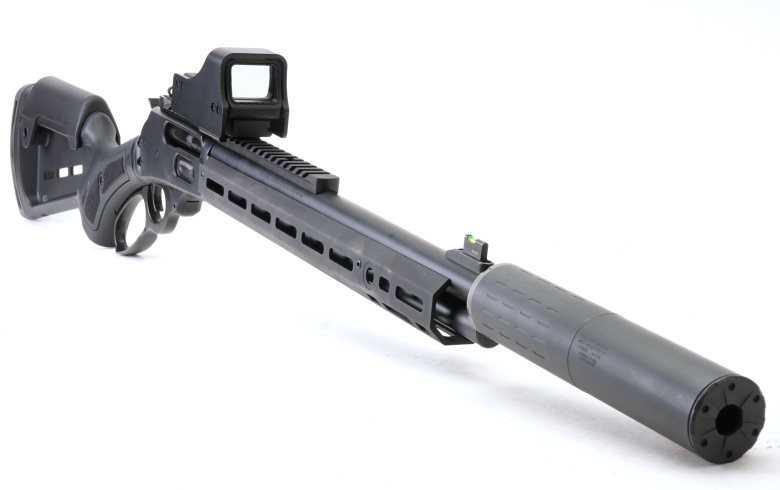
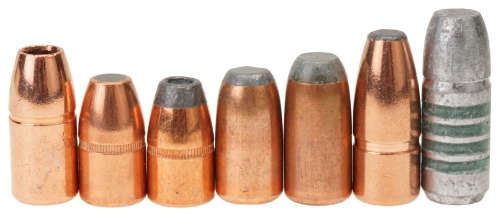
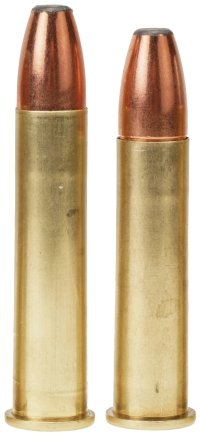
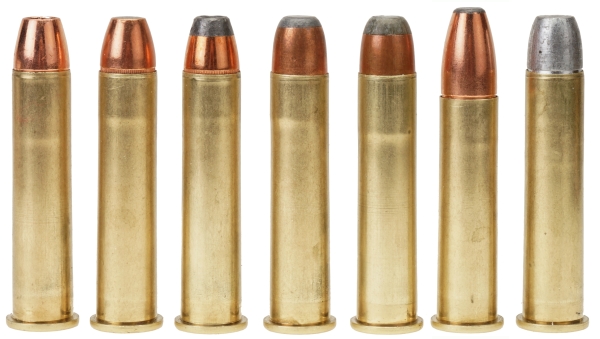

Email Notification